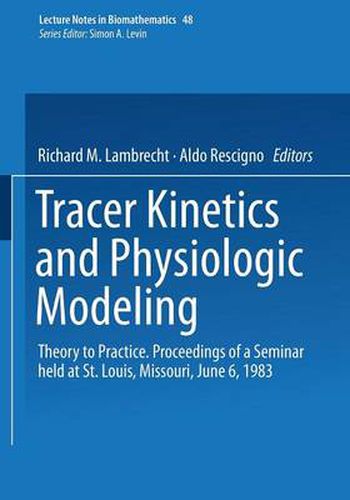Readings Newsletter
Become a Readings Member to make your shopping experience even easier.
Sign in or sign up for free!
You’re not far away from qualifying for FREE standard shipping within Australia
You’ve qualified for FREE standard shipping within Australia
The cart is loading…






This title is printed to order. This book may have been self-published. If so, we cannot guarantee the quality of the content. In the main most books will have gone through the editing process however some may not. We therefore suggest that you be aware of this before ordering this book. If in doubt check either the author or publisher’s details as we are unable to accept any returns unless they are faulty. Please contact us if you have any questions.
These lectures were prepared by the authors for Seminars to be held on June 6, 1983, in St.Louis, Missouri, under the spon- sorship of the Radiopharmaceutical Science Council of the So- ciety of Nuclear Medicine . All manuscript? were refereed . Tracer kinetics and the modeling of physiological and bio- chemical processes in vivo are the focus of a contemporary di- rection in biochemical research. Recent advances in instrumen- tation (especially positron emission tomography and digital autoradiography) and parallel developments in the production of short-lived radionuclides and rapid synthetic chemistry to pre- pare tracers that probe metabolism, flow, receptor-ligand kinetics, etc., are responsible for new scientific frontiers. These developments, coupled with biomathematics and computer science, make it possible to quantitatively evaluate tracer kinetic models in animals and man. (The choice of animal models in radiotracer design and tracer kinetics is the subject of a book edited by R.M.Lambrecht and W.C.Eckleman in press at Sprin- ger Verlag.) Tracer kinetics and physiological modeling is truly multi- disciplinary, as evidenced by the intellectual diversity and international representation observable in the list of contri- butors . The lectures outline and attempt to show the transition from the theoretical description to the practical application of modeling for understanding normal and pathological processes .
$9.00 standard shipping within Australia
FREE standard shipping within Australia for orders over $100.00
Express & International shipping calculated at checkout
This title is printed to order. This book may have been self-published. If so, we cannot guarantee the quality of the content. In the main most books will have gone through the editing process however some may not. We therefore suggest that you be aware of this before ordering this book. If in doubt check either the author or publisher’s details as we are unable to accept any returns unless they are faulty. Please contact us if you have any questions.
These lectures were prepared by the authors for Seminars to be held on June 6, 1983, in St.Louis, Missouri, under the spon- sorship of the Radiopharmaceutical Science Council of the So- ciety of Nuclear Medicine . All manuscript? were refereed . Tracer kinetics and the modeling of physiological and bio- chemical processes in vivo are the focus of a contemporary di- rection in biochemical research. Recent advances in instrumen- tation (especially positron emission tomography and digital autoradiography) and parallel developments in the production of short-lived radionuclides and rapid synthetic chemistry to pre- pare tracers that probe metabolism, flow, receptor-ligand kinetics, etc., are responsible for new scientific frontiers. These developments, coupled with biomathematics and computer science, make it possible to quantitatively evaluate tracer kinetic models in animals and man. (The choice of animal models in radiotracer design and tracer kinetics is the subject of a book edited by R.M.Lambrecht and W.C.Eckleman in press at Sprin- ger Verlag.) Tracer kinetics and physiological modeling is truly multi- disciplinary, as evidenced by the intellectual diversity and international representation observable in the list of contri- butors . The lectures outline and attempt to show the transition from the theoretical description to the practical application of modeling for understanding normal and pathological processes .